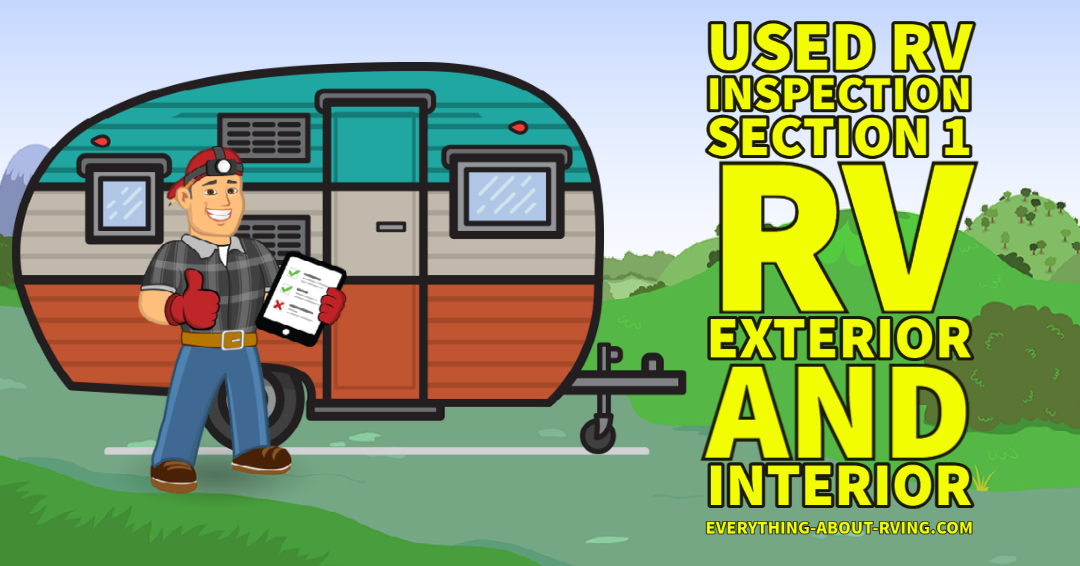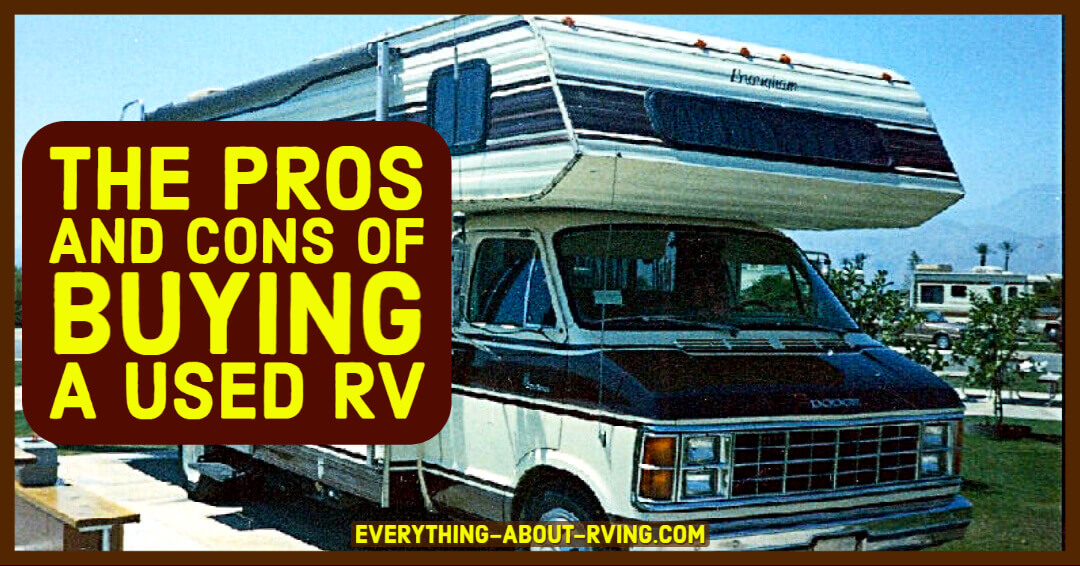- Home Page
- How to Do a Used RV Inspection
- Rv Inspection
Used RV Inspection
Section 1
RV Exterior and Interior
RV Inspection Section 1 includes tips for inspecting the documentation, exterior and interior of a Used RV
In this section of the Used RV Inspection Guidelines we are going to discuss how to review the documentation that the sellers have on the RV your looking at.
The RV documentation will give you an idea on what kind of maintenance and repairs have been done on the RV, as well as information on what accessories may have been added to the RV since it was originally purchased.
We will also go over what to look for when inspecting the exterior and interior of a used RV.
These are just guidelines and may not cover everything, but they are a good starting point for your RV inspection.
RV Documentation Review
- Has the RV been maintained properly. Does the current owner have receipts for routine maintenance such as oil change, air filters etc (If the RV has a generator, there should be receipts for routine maintenance on that as well). If they don't have these maintenance records, you need to find out why not.
- Do they have the original owner's manuals for the RV and it's accessories? If not, why not?
- Do they have documentation on any repairs that have been performed on the RV?
- Do they have documentation on any accessories they may have added to the RV?
- You also need to determine if they are the original owners of the RV.
- During this review ask the owners if there are any current problems with the RV (you may be surprised at some of the answers you get to this question).
RV Exterior
Please Note: If you had decided to take the RV you are interested in to an RV Inspection facility or dealership, there is a pretty good chance that their facility would have a lift or a pit that could be used to give a more thorough inspection of the undercarriage of the RV. We do not recommend that you, your friend or expert climb under the RV during your RV Inspection.
- Look under RV for any leaking fluids, signs of rust damage and any wires or accessories hanging loose. (don't stick finger in leaking fluids and put them in your mouth, so you can figure out what is actually leaking).
- Check exterior paint, fiberglass for accident damage, paint fading, delaminating or separation of the body skin.
- Check RV roof for loose components or apparent cracks in fiberglass (fiberglass roof). Check for any cuts in roof (rubber roof).
- Check all exterior lights for proper operation headlights, marker lights, porch lights etc.
- Check all exterior storage compartments for proper operation of doors and signs of leakage.
- Check all exterior windows, windshield etc. for cracks or damage. (good time to check the wiper blades and proper wiper and washer operation)
- Check all accessories attached to the exterior of RV for looseness and proper operation (ladders, awnings etc.)
- Check tires, wheels, suspension for signs of damage or wear. It should be noted here that many Tire Manufacturers, RV Manufacturers and expert RVers recommend that RV tires over 5 years old should be replaced even if tire wear or damage is not visible ( this is due to the chemical makeup of the tire and we are not going to go into a lengthy discussion here as to why this is needed, but keep this in mind during your inspection as well as figuring it into your cost of maintaining the RV). This would also be a good time to look at the brake pad thickness if you can see them through the wheels.
- Check all towing devices for damage or signs of rust damage etc. (this would also be a good time to check the towing electrical system)
- Check the weather stripping and proper operation of all room slide-outs.
- Check all external appliance vents for blockage or leakage. (small birds and rodents love to make their homes here).
- Check all of the external water, sewer and electrical hookups etc. for proper operation.
- Check condition of spare tire if so equipped.
- Check doors and locks for proper operation.
- If equipped with electric steps check for proper operation.
- Check the generator for leakage and apparent signs of damage (this is also a good time to check the oil level of the generator as well as seeing if the oil appears dirty or smells burnt). The generator should also be started so you can check that it is not smoking or making excessive noise (excessive noise can be a sign of an exhaust leak that could allow Carbon Monoxide to enter the living area of the RV).
- Check the Propane system for leaks, proper operation etc. (Don't use lighters or matches to check for propane leaks, just making sure).
- Check any exterior house and engine batteries for proper charge and electrolyte (battery acid) levels. Check for corrosion on battery connections. Check for loose or unconnected wires to the battery system.Are the batteries being charged by RV engine if so equipped. Are the batteries being charged when the generator is being run or the RV is connected to electric. If the RV is equipped with a solar charging system, is it functioning properly?
- Check the exterior water heater compartment for leakage and proper operation on propane and/or electricity.
Save 50% Off of Campsites with Passport America
RV Interior
- Check the interior living area of the RV for general wear and tear, torn carpet, furniture upholstery, curtains etc. Also inspect the ceiling for any signs of water damage, such as discoloration, dampness, mold or mildew.
- Do all the interior lights in the living area work?
- Do all the electrical outlets work?
- Do all the cabinet doors and drawers operate properly? When looking through all the cabinets and drawers (this is not considered snooping, because you are conducting an inspection) look for any signs of water damage, mold or mildew.
- Does the convertible bed convert to a bed, does the rocker/recliner actually rock and recline (sorry this is all getting too serious for us)?
- Do all of the appliances work properly? Does the refrigerator work on both electric and propane (if it is designed to do so)? Does the stove work?
- Is there mold or mildew apparent? Do the appliances appear clean? This would include, microwave, convection or conventional ovens.
- Do all of the sinks and showers work? This would also include making sure the toilet works properly (it is better to find out in advance that it won't flush rather than finding out when you're sitting on it).
- Does the water pump work?
- Do all the alarms work, Smoke, CO2, Propane etc? Also check all fire extinguishers for proper charge etc.
- Do all the RV gauges work, fresh water level, grey water level, black water level, propane level etc? Also take a look at the charging gauges for the house battery etc.
- Do all the switches for the water pump, room slides etc. operate properly?
- Does all the electronic equipment work, TVs, Satellite, TV antennae, home theater system, converters cd player (8 track player in older RVs) etc?
- Do all the windows go up and down or slide open depending on type of window? Are all the window screens in good shape?
- Do the day/night shades actually work properly (do not be surprised if there are problems with these, they may have to be re-strung, you can do the re-stringing yourself if you want to drive yourself insane)?
- Does the living area heating and air conditioning operate?
- Does the RV leveling system work properly?
- Are there any strange unidentifiable smells in the RV? If so, this would be a good time to check the exhaust and vent fans for proper operation.
We hope that these RV Inspection guidelines have been helpful to you. If you are looking at a motorized used RV, you may want to look at Section 2 of the RV Inspection information which covers inspecting the engine as well as outlining what to look for during your test drive of the RV.
Happy RVing (or Happy Future RVing if you have not bought an RV yet).
Do you have any suggestions or comments on this topic? You can add them to this page by using the comments section located below.
Return to the Used RV Inspection page from the RV Inspection Section 1, RV Exterior and Interior page




